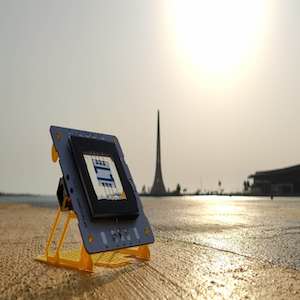Using AI to control energy for indoor agriculture
30 September 2024
Published online 29 February 2024
A new testing procedure can predict the real-world durability of a promising class of materials used for solar cell production.

Credit: Han Xu, KAUST
A new testing procedure can predict the real-world durability of a promising class of materials used for solar cell production.
Most days in Saudi Arabia are filled with blazing sunlight, which provides the perfect conditions to use organic solar cell (OSC) technology which turns building facades and other surfaces into steady sources of power. However, relentless exposure to high temperatures can also degrade many OSC materials, rendering them ineffective. A study by a team including Derya Baran, who researches material science and engineering at King Abdullah University of Science and Technology (KAUST), explores ways to overcome this problem by identifying the chemical features of materials that can reliably predict their OSC stability in real-world conditions (H. Xu et al. Joule 7, 2135–2151; 2023).
OSCs are polymer-based photovoltaic systems that generate power when a source of light excites the electrons within a ‘donor’ material, which are subsequently transferred to an adjacent ‘acceptor’ material. OSCs generally have a number of advantages over silicon-based photovoltaics as they are lightweight, flexible and semi-transparent.
“Potential applications of OSCs include powering internet-of-things devices, integration into buildings and facades as well as net-zero greenhouses for agriculture,” says Han Xu, a graduate student in Baran’s lab and first author of the study.
Xu and Baran are particularly interested in OSC designs that use Y-series non-fullerene acceptors (Y-NFAs), which achieve excellent light absorption and are efficient in transforming light into electrical power. However, there are a host of possible Y-NFA materials and many are susceptible to damage and degradation from heat, moisture, ultraviolet radiation and other external factors, which limit their durability and reliability.
Without a fundamental understanding of the physicochemical properties of a given material, OSC development quickly turns into a “search for the right molecular needles among a semi-infinite molecular haystack,” according to Quinn Burlingame, a solar cell researcher at Princeton University who was not involved in this study.
This is where Baran’s team come in. As a relatively new class of materials, there isn’t enough experimental data on the performance of different Y-NFA-based OSC outside the laboratory environment. Xu explains that there were two main issues behind this – the lack of effective encapsulation technology to protect the OSCs and a lack of convenient testing apparatus. To address the first issue, the researchers employed a polyurethane encapsulation process developed in the lab of KAUST colleague and co-author Stefaan De Wolf (R. Azmi et al. Science 376, 73–77; 2022) to insulate their OSCs against water and oxygen, both of which can promote degradation. In parallel, Baran’s lab developed an apparatus that combines open-source software and hardware to enable the systematic testing of OSC stability and power generation over extended periods of time in outdoor environments.
The authors performed laboratory tests on a set of four different Y-NFA materials with distinct compositional differences: for example, incorporating fluorine versus chlorine atoms, or with varying lengths of chemical chains. They assessed how these materials responded to light-induced ‘ageing’ in the lab, exposing the material to a plasma lamp that replicates solar illumination at room temperature. The researchers then fabricated encapsulated OSCs based on the same Y-NFAs and performed outdoor testing. This allowed them to see how well the predictions from controlled conditions held up after prolonged exposure to the heat of the Saudi Arabian sun, which can warm OSCs to temperatures of more than 65°C.
They were pleasantly surprised by the findings. “The connection between outdoor stability results and laboratory light stability results is clear,” says Xu. This indicates that a well-designed experimental set-up based on light-induced ageing at moderate temperatures can meaningfully predict a Y-NFA material’s ability to withstand heat damage outside and should pave the way for more efficient testing and development of OSCs.
Their results also revealed features of different Y-NFA materials that directly affect their performance in these tests and the stability of different chemical compositions. Burlingame is especially enthusiastic about this aspect of the work. “This is an important step in improving our collective understanding of how chemistry affects OSC stability and paves the way for future studies that use targeted chemical substitutions to achieve OSCs with commercially viable lifetimes,” explains Xu.
Stability, however, is only one of many parameters under consideration, and the acceptor material itself is just a single component of the more complex device. “Factors such as electrodes, interfaces, donors, acceptors and encapsulation, significantly influence stability. Addressing all these issues is bound to prompt trade-offs in terms of cost and efficiency,” adds Xu. Identifying Y-NFA designs with an optimal balance will be a major goal for Baran’s team. Xu says that they will continue to search for other vulnerabilities that could affect the broader adoption of OSCs as a practical commercial solution for the production of power.
doi:10.1038/nmiddleeast.2024.70
Stay connected: